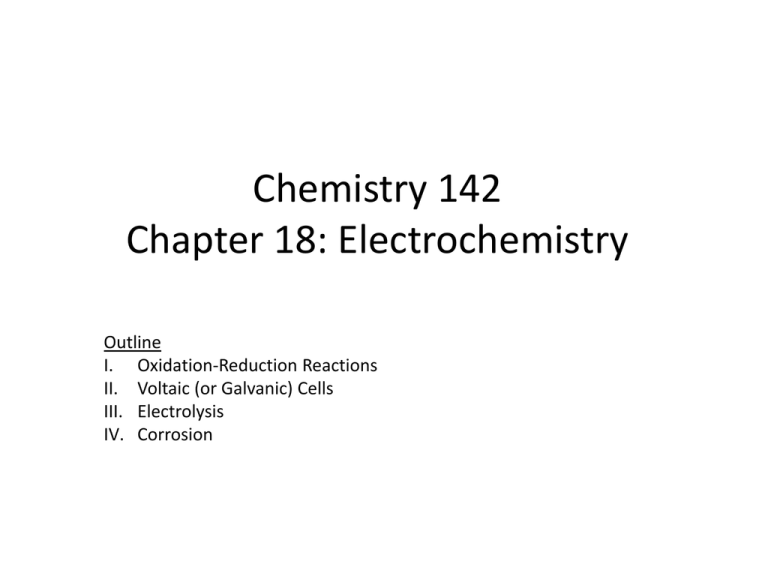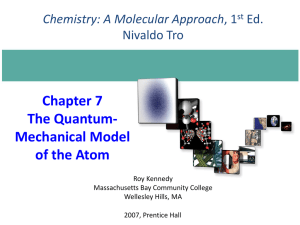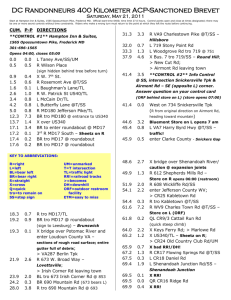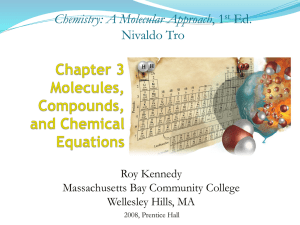Chemistry 142 Chapter 17: Electrochemistry
advertisement

Chemistry 142 Chapter 18: Electrochemistry Outline I. Oxidation-Reduction Reactions II. Voltaic (or Galvanic) Cells III. Electrolysis IV. Corrosion Electric Current Flowing Directly Between Atoms Tro, Chemistry: A Molecular Approach 2 Electric Current Flowing Indirectly Between Atoms Tro, Chemistry: A Molecular Approach 3 Fe(s) | Fe2+(aq) || MnO4(aq), Mn2+(aq), H+(aq) | Pt(s) Tro, Chemistry: A Molecular Approach 4 Tro, Chemistry: A Molecular Approach 5 Activity Series Chapter 18 – Electrochemistry Example – Cell Potential 18.1 Consider a Galvanic cell based on the reaction: Al3+ (aq) + Mg (s) Al (s) + Mg2+ (aq) Given the half reactions: Al3+ (aq) + 3 e- Al (s) E˚ = -1.66 V Mg2+ (aq) + 2 e- Mg (s) E˚ = -2.37 V Chapter 18 – Electrochemistry Example – Cell Potential 18.2 What is the cell potential of the following Galvanic cell? Pt (s)|ClO3- (aq), ClO4- (aq), H+ (aq)|| H+ (aq), MnO4- (aq), Mn2+ (aq)|Pt (s) Given the cell potentials: Eoxidation˚ = 1.19 V Ereduction˚ = 1.51 V Chapter 18 – Electrochemistry Example – Cell Potential 18.2 What is the cell potential of the following Galvanic cell? Pt (s)|ClO3- (aq), ClO4- (aq), H+ (aq)|| H+ (aq), MnO4- (aq), Mn2+ (aq)|Pt (s) Given the half-reactions: MnO4- (aq) + 8 H+ (aq) + 5 e- Mn2+ (aq) + 4 H2O (l) E˚ = 1.51 V ClO4- (aq) + 2 H+ (aq) + 2 e- ClO3- (aq) + H2O (l) E˚ = 1.19 V Chapter 18 – Electrochemistry Example – Cell Potential 18.3 Describe completely the Galvanic cell based on the following half-reactions under standard conditions: Ag+ (aq) + e- Ag (s) E˚ = 0.80 V Fe3+ (aq) + e- Fe2+ (aq) E˚ = 0.77 V Chapter 18 – Electrochemistry Example – Cell Potential 18.4 Describe completely the Galvanic cell based on the following half-reactions under standard conditions: Fe2+ (aq) + 2 e- Fe (s) E˚ = -0.44 V MnO4- (aq) + 8 H+ (aq) + 5 e- Mn2+ (aq) + 4 H2O (l) E˚ = 1.51 V Chapter 18 – Electrochemistry Example – Cell Potential 18.5 What is the efficiency of a Galvanic cell that has a maximum potential of 2.50 V, if 1.33 moles of electrons is passed through a cell with an average potential of 2.10 V? Chapter 18 – Electrochemistry Example – Cell Potential and Free Energy 18.6 The following process is used to deposit copper metal from copper ore, calculate ΔG˚ for: Cu2+ (aq) + Fe (s) Fe2+ (aq) + Cu (s) Is the reaction spontaneous? Given: Cu2+ (aq) + 2 e- Cu (s) E˚ = 0.34 V Fe2+ (aq) + 2 e- Fe (s) E˚ = -0.44 V Concentration Cell Cu(s) Cu2+(aq) (0.010 M) Cu2+(aq) (2.0 M) Cu(s) Tro, Chemistry: A Molecular Approach 17 Chapter 18 – Electrochemistry Example – Concentration Cell 18.7 For the reaction: 2 Al (s) + 3 Mn2+ (aq) 2 Al3+ (aq) + 3 Mn (s) Ecell˚ = 0.48 V Predict the larger or small Ecell˚ given : a. [Al3+] = 2.0 M and [Mn2+] = 1.0 M b. [Al3+] = 1.0 M and [Mn2+] = 3.0 M Chapter 18 – Electrochemistry Example – Concentration Cell 18.8 Ecell˚ is 0.48 V for the Galvanic cell based on the reaction below: 2 Al (s) + 3 Mn2+ (aq) 2 Al3+ (aq) + 3 Mn (s) Consider a cell in which [Al3+] = 1.50 M and [Mn2+] = 0.50 M. Calculate the cell potential, Ecell, at 25 ˚C. Chapter 18 – Electrochemistry Example – Concentration Cell 18.9 Consider the following Galvanic cell at 25 ˚C with a Ecell of 0.58 V: Zn (s)|Zn2+ (aq) (1 M)|| H+ (aq) (? M)| H2 (g) (1 atm)|Pt (s) What is the pH of the solution? Given the two half-reactions: 2 H+ (aq) + 2 e- H2 (g) E˚ = 0 V Zn2+ (aq) + 2 e- Zn (s) E˚ = -0.76 V Chapter 18 – Electrochemistry Example – Concentration Cell 18.10 For the unbalanced redox reaction below calculate E° and K at 25 °C. S4O62- (aq) + Cr2+ (aq) Cr3+ (aq) + S2O32- (aq) Given the half-reactions: S4O62- (aq) + 2 e- S2O32- (aq) E˚ = 0.17 V Cr3+ (aq) + e- Cr2+ (aq) E˚ = -0.50 V Neuron Potential Ion Na+ K+ Cl– Ca2+ Intracellular conc. (mM) 18 Extracellular conc. (mM) 150 135 7 0.0001 3 120 1.2 Potential (mV) +56 -102 -76 +125 The pH Electrode Cell Types Characteristic Voltage of Common Cells Voltaic Cell Common alkaline battery Voltage 1.5V Lead-acid storage battery (6 cells = 12V) 2.0V Mercury calculator battery 1.3V Electric eel (5000 cells = 750V) 0.15V Nerve of giant squid 0.070V LeClanche’ Acidic Dry Cell • electrolyte in paste form – ZnCl2 + NH4Cl • or MgBr2 • anode = Zn (or Mg) Zn(s) Zn2+(aq) + 2 e- • cathode = graphite rod • MnO2 is reduced 2 MnO2(s) + 2 NH4+(aq) + 2 H2O(l) + 2 e 2 NH4OH(aq) + 2 Mn(O)OH(s) • cell voltage = 1.5 v • expensive, nonrechargeable, heavy, easily corroded Tro, Chemistry: A Molecular Approach 27 Alkaline Dry Cell • same basic cell as acidic dry cell, except electrolyte is alkaline KOH paste • anode = Zn (or Mg) Zn(s) Zn2+(aq) + 2 e- • cathode = brass rod • MnO2 is reduced 2 MnO2(s) + 2 NH4+(aq) + 2 H2O(l) + 2 e- 2 NH4OH(aq) + 2 Mn(O)OH(s) • cell voltage = 1.54 v • longer shelf life than acidic dry cells and rechargeable, little corrosion of zinc Tro, Chemistry: A Molecular Approach 28 Lead Storage Battery • 6 cells in series • electrolyte = 30% H2SO4 • anode = Pb Pb(s) + SO42-(aq) PbSO4(s) + 2 e- • cathode = Pb coated with PbO2 • PbO2 is reduced PbO2(s) + 4 H+(aq) + SO42-(aq) + 2 e- PbSO4(s) + 2 H2O(l) • cell voltage = 2.09 v • rechargeable, heavy Tro, Chemistry: A Molecular Approach 29 The Lead-acid Battery in Cars Discharge of a Lead-acid Battery Nickel-metal Hydride Battery Mercury Button Cell Lithium Ion Battery • electrolyte is concentrated KOH solution • anode = graphite impregnated with Li ions • cathode = Li - transition metal oxide – reduction of transition metal Tro, Chemistry: A Molecular Approach 34 Lithium-Ion Batteries Tro, Chemistry: A Molecular Approach 36 Fuel Cell Example Fuel Cells Tro, Chemistry: A Molecular Approach 38 Fuel Cell Tro, Chemistry: A Molecular Approach 40 Electroplating Tro, Chemistry: A Molecular Approach 41 Production of Na Molten NaCl Electrolysis of Water Tro, Chemistry: A Molecular Approach 44 Production of Cl2 Production of Al Chapter 18 – Electrochemistry Example – Electrolytic Cell 18.9 How much copper can plate out when 10.0 amps (1 A = 1 C/s) of current is used over a 30.0 minute period through a solution of 1.00 M cupric ions (cupric sulfate solution) with a power source greater than 1.10 V? Cu (s) + Zn2+ (aq) Zn (s) + Cu2+ (aq) Electrolytic Cells Electrorefining Chapter 18 – Electrochemistry Example – Electrolysis of Ions 18.10 If a solution contains Cu2+, Ag+, and Zn2+ and the voltage starts out low and is gradually turned up in which order will the metals plate? Given: Ag+ (aq) + e- Ag (s) E˚ = 0.80 V Cu2+ (aq) + 2 e- Cu (s) E˚ = 0.34 V Zn2+ (aq) + 2 e- Zn (s) E˚ = -0.76 V Chapter 18 – Electrochemistry Example – Electrolysis of Ions 18.11 To electrodeposit all of the Cu and Cd from a solution of CuSO4 and CdSO4 required 1.20 F of electricity (1 F = 1 mol e-). The mixture of Cu and Cd that was deposited had a mass of 50.36 g. What mass of CdSO4 was present in the original mixture? Corrosion Rust Prevention Sacrificial Anode Tro, Chemistry: A Molecular Approach 54











